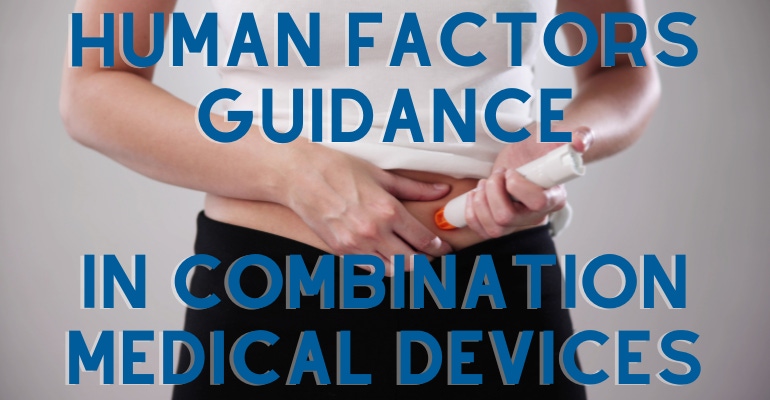FDA Finalizes Human Factors Guidance in Combination Medical Devices
The guidance focuses on applying HFE principles for medical devices combined with a drug or biological product.

Replacing a draft guidance issued in February 2016, FDA recently finalized its guidance on the use of human factors engineering (HFE) in the development of combination medical devices with a drug or biological product. The Application of Human Factors Engineering Principles for Combination Products document, released in a Q&A format, pertains to combination products submitted to the Center for Biologics Evaluation and Research, the Center for Devices and Radiological Health, or the Center for Drug Evaluation and Research. The agency recommends the guidance be read in conjunction with Applying Human Factors and Usability Engineering to Medical Devices and Safety Considerations for Product Design to Minimize Medication Errors.
HFE uses the knowledge of human behavior, and an individual’s abilities, and limitations to design products better able to be used safely and effectively. Additionally, intended user population characteristics must be considered as specific limitations could impact use of the product.
“For example, for a digital health combination product intended for use in a geriatric patient population, common characteristics or limitations may include decreased vision/hearing, varying literacy levels, and cognitive decline,” according to the guidance document. “Furthermore, the design of the combination product should take into account, among other things, the use environment(s), including any limitations (e.g., limited internet /cellular phone service).”
Adding to the guidance on the general principles of human factors, including information found in Applying Human Factors and Usability Engineering to Medical Devices, the FDA document specifies two unique definitions in HFE directed towards combination products — the final finished combination product and combination product critical task. A final finished combination product is the final form of a product intended for market and to be submitted in regulatory applications. The term includes the user interface for the product, like the proposed packaging, labels and labeling, as well as training if applicable.
A combination product critical task is a user task which, if performed wrong or not at all, would or could cause harm to the user themselves or the patient. FDA defines harm to include compromised medical care. While this definition is similar to that used in a standalone device, it differs in the level of harm. While a critical task in a standalone device only has the device itself to contend with, a combination product critical task is associated with risks in a combination product as a whole that don’t exist for the device alone or the drug alone.
“Therefore, combination product critical tasks reflect the use-related risks resulting from both the drug and device constituent parts used together as a combination product,�” according to FDA. “For a combination product critical task, compromised medical care includes consideration of medication errors.”
A comprehensive use-related risk analysis (URRA) can help determine combination product critical tasks. These analyses should include a systematic evaluation of all the tasks involved in using the combination product — based on a task analysis and should reflect on the use errors that may occur if the tasks are not completed — task failures. Additionally, combination devices must be studied for intended use, use environment, user interface, and the users.
In the guidance document, FDA noted that it is particularly interested in the assessment of tasks that directly impact dosing (overdosing, underdose, or missed dose), administration of the product (wrong site of administration, improper preparation of drug/biologic before administration), and the potential result in harm (physical injury, adverse events, events that ma need patient monitoring to confirm no harm, or events leading to hospitalization).
FDA highlighted specific examples of what would and wouldn’t be considered critical tasks. “Consider an autoinjector for repeat use that includes a task to remove the cap. If a user cannot initially remove the cap, then the user is initially delayed in the sequence of tasks. However, there is no sense of urgency associated with completion of tasks for this hypothetical combination product and the user ultimately removes the cap. In cases where the timeliness of the injection is not linked to physical injury, it’s unlikely that FDA would consider this task to be a combination product critical task.”
The document continued, writing, “Consider an autoinjector for a non-urgent, repeat use where the user must complete the task of pushing the needle end against the skin to activate the injection sequence and administer the dose. In this example, a user does not complete the task of pushing to activate the full injection sequence because the user did not know s/he needed to push the needle all the way down, and thus fails to administer the dose. The omission of a single dose is a medication error that may not result in an immediate change in clinical signs or symptoms; however, it is reasonable to consider the potential for repeated dose omission medication errors over the course of treatment. The treatment for that patient may be compromised and could result in harm to the patient. Thus, the task of pushing the needle end against the skin to activate the full injection sequence would be considered a combination product critical task.”
Other topics in the guidance included the differences between URRA to support the user interface compared to of types of risk analysis, writing, “the URRA is a subset of the full engineering risk analysis for the device constituent part and combination product as a whole (including the drug constituent part). For the purposes of this guidance, the URRA is the systematic use of available information to identify use-related hazards and to estimate the use-related risk.”
In another question related to how the agency evaluates human factor validation studies, FDA recognized the impossibility of designing a completely error-proof or risk-free user interface, noting that “some residual use-related risk may remain. The HF validation study results should be considered within the overall benefit-risk assessment of the combination product.”
About the Author(s)
You May Also Like





